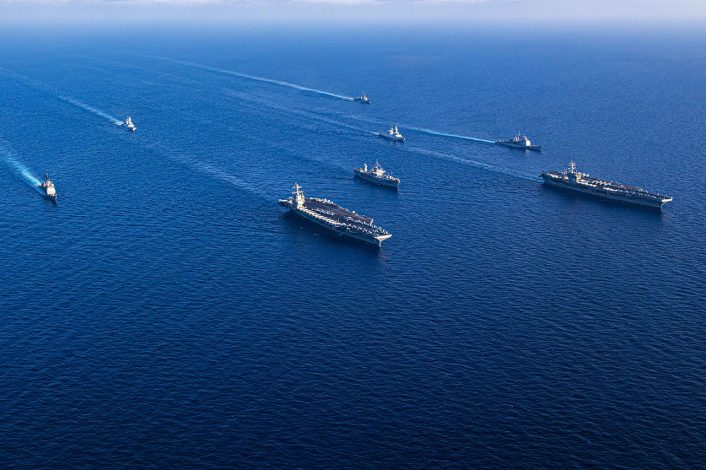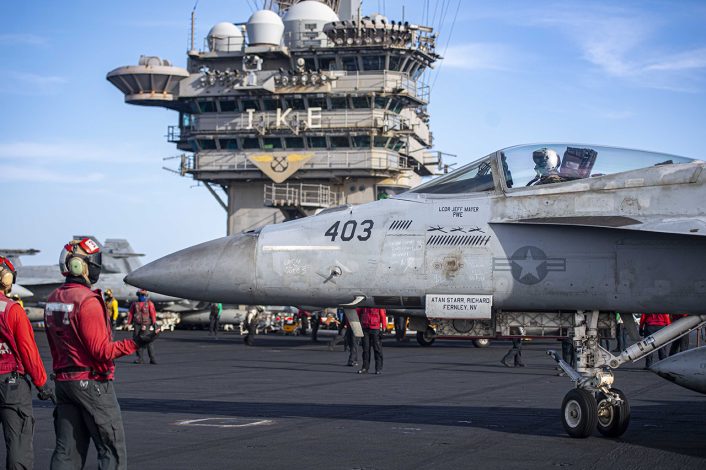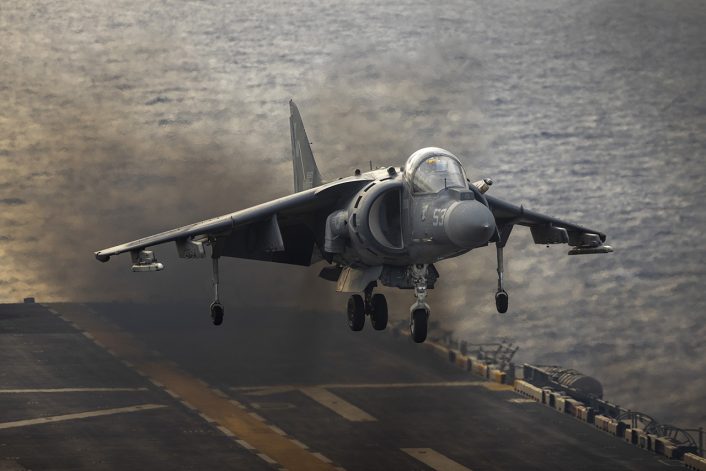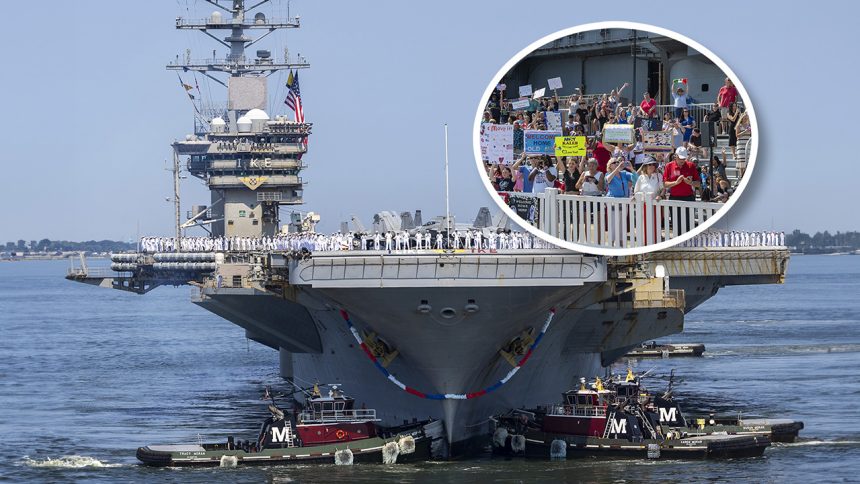After nine eventful months which saw extensive operations in the Red Sea, Gulf of Aden and Mediterranean Sea, the nuclear-powered aircraft carrier USS Dwight D. Eisenhower (CVN 69) finally arrived back in the United States on July 14, 2024.
Making many headlines during its lengthy and eventful deployment, the crews of the Eisenhower as well as its escort ships were met by scores of friends and family as they arrived at Naval Station Norfolk. Loved ones also greeted the crews of squadrons from Carrier Air Wing 3 as they arrived home to Naval Air Station Oceana on July 12.
Welcome home VFA-105!!! 🥳
All squadrons based at Naval Air Station Oceana that deployed with USS Dwight D. Eisenhower (@TheCVN69) to @USNavyEurope and @US5thFleet are now home. 🇺🇸🇺🇸🇺🇸 pic.twitter.com/OTREDr76la
— U.S. Fleet Forces (@USFleetForces) July 12, 2024
Commanding officer of the Eisenhower, Captain Chris ‘Chowdah’ Hill, has notably made significant efforts to keep morale boosted during their arduous tasking, making use of his X account to document the cookies which he gave to many members of his crew since they deployed. As of his final update, he had reportedly given out 54,000 cookies.
The official cookie count for this deployment: 54,000 given. Here’s a few more that haven’t been counted… pic.twitter.com/wFqOFtXxjL
— Chowdah Hill (@ChowdahHill) July 12, 2024
The Nimitz class aircraft carrier USS Dwight D. Eisenhower (CVN 69) was dispatched to the Eastern Mediterranean on Oct. 14, 2023 as a precautionary measure due to the current Israel-Hamas war which began a week prior. This deployment reinforced the USS Gerald R. Ford (CVN 78) aircraft carrier and carrier strike group which was also sent to the region.
Leading Carrier Strike Group 2 (CSG 2) the Eisenhower was escorted by guided missile destroyers USS Gravely (DDG 107), USS Laboon (DDG 58) and USS Mason (DDG 87) alongside Ticonderoga class guided missile cruiser USS Philippine Sea (CG 58).

During the strike group’s deployment to the Eastern Mediterranean, Houthi rebels in Yemen began a coordinated campaign of attacks against shipping in the busy and narrow Red Sea, which leads to the Suez Canal. The Eisenhower and its strike group were tasked with the protection of civilian and allied vessels in the area, as well as with the interdiction of Houthi attack capabilities.
Aircraft from Carrier Air Wing 3 (CVW 3), deployed on the Eisenhower, assisted the destroyer and cruiser escorts by launching air to air sorties against incoming missiles and drones. F/A-18 Super Hornets were seen launching from the aircraft carrier with unusual payloads featuring large amounts of air to air missiles. These aircraft were then seen decorated with kill marks, denoting the various types of aerial targets each airframe had successfully engaged alongside other marks symbolizing successful ground strike missions.

The Eisenhower’s departure home in late June led to a brief carrier gap, with no U.S. Navy aircraft carriers assigned to either the Fifth Fleet or Sixth Fleet areas of responsibility until the arrival of the USS Theodore Roosevelt (CVN 71) on July 12. The Wasp Amphibious Ready Group (ARG), comprising the USS Wasp (LHD 1), USS New York (LPD 21) and USS Oak Hill (LSD 51), was positioned in the Mediterranean Sea during this time to cover, and currently remains there while the Roosevelt operates east of Suez.
While the capabilities of the ARG cannot match those of a Carrier Strike Group, U.S. Marine Corps Harriers previously deployed on the USS Bataan (LHD 5) reported many successful air to air engagements using their aircraft to defend ships against Houthi attacks. The Wasp ARG is also equipped with Harriers, and these took part in the BALTOPS 24 exercise in Northern Europe in June.

In the Pacific region, the Roosevelt’s position in the Seventh Fleet will be assumed by the USS Abraham Lincoln (CVN 72), which departed California on July 11. The USS Ronald Reagan (CVN 76) is also currently operating in the Seventh Fleet area of responsibility, taking part in its final patrol of the region before returning to the United States later in the year. The Reagan has been homeported in Yokosuka, Japan since 2015, replacing the USS George Washington (CVN 73), but now the Washington has completed the Refueling and Complex Overhaul (RCOH) program it will return to Japan and assume its previous role as the only permanently forward deployed US aircraft carrier.
This delicate balance of carrier deployments demonstrates how even the world’s largest aircraft carrier force can be stretched by increasingly demanding requirements worldwide, simultaneously burdened by the necessity of lengthy refueling periods for nuclear-powered aircraft carriers which can take ships out of the fleet for years at a time. While the scheduling for these has been carefully planned for many years, the COVID-19 pandemic and other delays have hampered the overhaul process.
Sat image of Newport News Shipbuilding from Feb this year. On the top left, the future USS Enterprise (CVN-80) comes together, while on the bottom right USS John C. Stennis (CVN-74) is undergoing a four year Refueling and Complex Overhaul (RCOH). pic.twitter.com/6jyC2LVAWe
— Zach (@ThrustWR) March 29, 2024
Delivery of the U.S. Navy’s newest Gerald R. Ford class carrier, the USS John F. Kennedy (CVN 79) is not due to take place until 2025, although crucially unlike the class’ namesake it is planned to be delivered with the capability to operate the F-35C Lightning II. The Kennedy’s delivery will allow the deactivation of the USS Nimitz (CVN 68) which is currently scheduled to soldier onto 2026, extended from the original date of 2025. If the 2026 plan goes ahead, the Nimitz will have been in commission for 51 years at the time of retirement.









